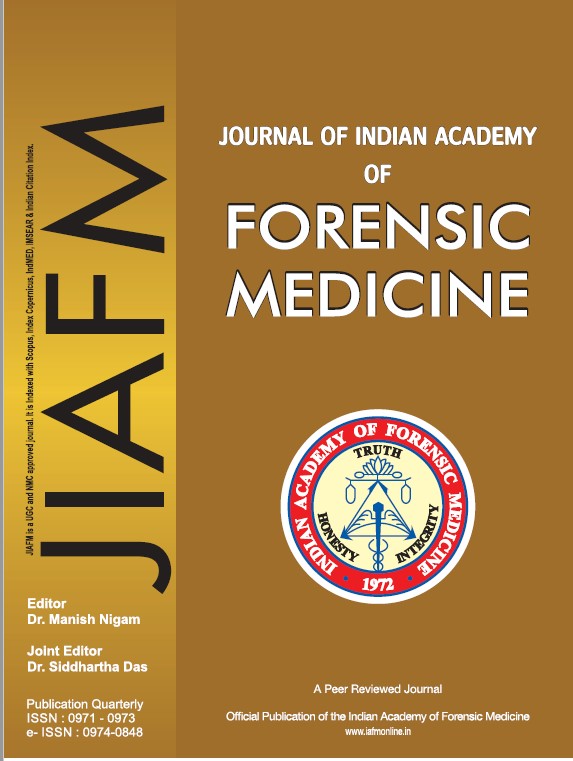A Suicidal Death which was Treated and Masqueraded as an Accidental Death
DOI:
https://doi.org/10.48165/jiafm.2023.45.4.27Keywords:
Misleading history, Organophosphate poisoning, Snake bite, Suicidal death autopsyAbstract
The work of an autopsy surgeon revolves not only around performing autopsy of the body but it also requires ruling out every single possibility, relevant or remote, even if the possibility of it, actually happening is as thin as a whisker before coming to formulation of opinion. It is not uncommon for an autopsy surgeon to come across cases wherein there is a stark contrast between what is being claimed and that which is evident. History is manipulated for a plethora of reasons, one prominent reason being eschewing the societal stigma associated with suicide as a consequence of probable sexual assault in a rural place. This is one such case wherein a 15 years old female was brought to the hospital with a history of being bitten by a snake which was witnessed by the deceased's father. Thereafter, treatment was provided at the hospital after taking the history into account. After almost 48 hours of survival, she was certified dead and owing to the unnatural death, an autopsy was deemed necessary. The lack of evidence supporting snake bite, certain incidental findings during the autopsy along with the reconstruction of events based on the circumstantial evidence led to the conclusion that this was a case of suicidal death caused by ingestion of a poisonous substance and not that of an accidental death as a consequence of snake bite.
Downloads
References
Menezes RG, Monteiro FN. Forensic Autopsy. [Updated 2023 Sep 4]. In: StatPearls [Internet]. Treasure Island (FL): StatPearls Publishing. [cited 2023 Dec 21 ]; 2023. Jan. Available from: https://www.ncbi.nlm.nih.gov/books/
NBK539901/
Simpson K. The investigation of obscure deaths. Can Med Assoc J. 1964 Oct 17;91(16):845-50.
Silva HA, Ryan NM, Silva HJ. Adverse reactions to snake antivenom, and their prevention and treatment. Br J ClinPharmacol. 2016 Mar; 81(3): 446–52.
Medscape. Organophosphate toxicity medication. [Internet] [updated 2023 Mar 13; cited 2023 Dec 21]; Available from: https://emedicine.medscape.com/article/167726-medication ?form=fpf
Eddleston M, Dawson A, Karalliedde L, Dissanayake W, Hittarage A, Azher S et al. Early management after self poisoning with an organophosphorus or carbamate pesticide – a treatment protocol for junior doctors. Crit Care. 2004;8: R391-7.
Connors NJ, Harnett ZH, Hoffman RS. Comparison of current recommended regimens of atropinization in organophosphate poisoning. J Med Toxicol. 2014; 10: 143–7.
Warrell DA. WHO/SEARO Guidelines for the clinical management of snakebite in the Southeast Asian Region. SE Asian J Trop Med Pub Hlth. 1999;30:1-85.
Moied SA, Mohib A, Abu N, Jyotsna M, Adarash C, Jyotishka P. Emergency treatment of a snake bite Pearls from literature. Journal of Emergencies, Trauma and Shock. Jul–Dec 2008; 1(2):p 97-105.
Kleinschmidt K, Ruha AM, Campleman S, et al. Toxic North American Snakebite Registry Group. Acute adverse events associated with the administration of Crotalidae polyvalent immune Fab antivenom within the North American Snakebite Registry. ClinToxicol (Phila). 2018; 56:1115–20.
Premawardena AP, de Silva CE, Fonseka MMD, Gunatilake SB, de Silva HJ. Low dose subcutaneous adrenaline to prevent acute adverse reactions to antivenom serum in snake bite: a randomized placebo‐controlled trial. BMJ 1999; 318: 730–3.
Ariaratnam CA, Sjöström L, Raziek Z, Kularatne SA, Arachchi RW, Sheriff MH, Theakston RD, Warrell DA. An open, randomized controlled trial of two antivenoms for the treatment of envenoming by Sri Lankan Russell's viper (Daboia russelli russelli). Trans R Soc Trop Med Hyg 2011; 95: 74–80.
Gawarammana IB, Kularatne SA, Dissanayake WP, Kumarasiri RP, Senanayake N, Ariyasena H. Parallel infusion of hydrocortisone +/− chlorpheniramine bolus injection to prevent acute adverse reactions to antivenom for snakebites: a randomized, double blind, placebo controlled study. Med J Aust 2004; 180: 20–3.
De Silva HA, Pathmeswaran A, Ranasinha CD, Jayamanne S, Samarakoon SB, Hittharage A et al. Low dose adrenaline, promethazine, and hydrocortisone in the prevention of acute adverse reactions to antivenom following snakebite: a randomized, double blind, placebo controlled trial. PLoS Med 2011; 8: e1000435.


